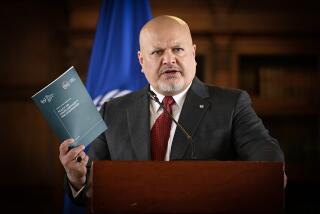No Room in His Class for ‘Can’t’
His stunted, shriveled arms are all but useless when it comes to driving, bodyboarding or teaching science to sixth-graders.
Instead, Chris Gallagher accomplishes all three with his feet, and a fierce determination to overcome adversity that is inspiring children at San Juan Capistrano’s Marco Forster Middle School, where he is a first-year math and science teacher.
Since being born without functional arms 37 years ago, Gallagher has tried to use what he’s been given to be a positive role model.
“ ‘Can’t’ is not in my vocabulary,” Gallagher said. “Whenever students feel like giving up on something, I tell them to take the word out of theirs, too.”
As Gallagher led his classes through the mysteries of algebraic equations and the solar system Wednesday morning, he did nearly everything with his knobby, muscular feet: flipping pages and passing markers to students, explaining the seasons by clutching a pen in one foot and a pencil in the other to represent Earth and the sun.
He spent most of his math class at the board, scribbling with his right foot while reclined on a chair with its seat cranked 3 feet in the air. He goes barefoot in his classroom, his brown leather clogs under his desk.
He rarely uses his upper body, occasionally indicating with his shoulder a part of a fraction or angling the seat of his chair with his hand. Most of the time, his hands hang idle near his hips, almost hidden by the short sleeves of his green and black Hawaiian shirt.
Gallagher’s students said they hear other kids at the school make fun of their teacher, but they shrug off the remarks.
“If they were in this class, they would see he can do everything we can,” said J.R. Costello, 12. “Most things he can do better.”
Gallagher started as a substitute teacher for the Capistrano Unified School District five years ago after closing the Carlsbad surf shop he had run for five years. When the economy started going south, Gallagher considered becoming a pastor or a university history professor but settled on teaching at the elementary level because it would allow him to touch the most young lives.
As a substitute, he had a guaranteed way of quieting kids at the beginning of the day: writing his name on board with his foot. “The classroom goes pretty silent at that point,” he said. “All you’ll hear is ‘whoa.’ ”
After introducing himself, he told kids about his condition, called arthrogryposis -- about how one in 3,000 babies is born with it when too much calcium in a mother’s womb fuses the bones together -- then invited questions.
Younger kids, he said, would ask anything, no matter how pointed or blunt:
“Why are your hands like that?”
“How do you shave?”
“How did you learn to use your feet?”
“They don’t hold back at all,” said Gallagher, laughing. “It’s kind of refreshing.”
In contrast, parents have never talked to Gallagher about his disability during school events such as back-to-school nights, he said.
Gallagher said most of his teaching challenges -- creating course materials and tests from scratch, for example -- are due to his status as a first-year teacher, not his disability. Others, such as connecting with every student in his class, no matter what their abilities, are inherent to teaching.
Some of the everyday tasks that go along with his job are hard for Gallagher, including photocopying and changing bulletin board displays.
Still, his room has the typical math and science clutter, including drawings of dinosaurs on the walls and student-made plastic-foam models of Earth dangling from the ceiling.
There are also touches that are pure Gallagher, including hockey posters, a surfer screen saver and the word “aloha,” encircled by planets, glued on the window.
Since he now has the same students all year, Gallagher must be more creative in capturing kids’ attention. Sometimes he uses his foot to flip, then catch, a marker. Once during class Wednesday he held his big toe to his lips and shushed the children.
It worked -- the kids giggled, then fell silent.
Most of the time, though, his students no longer notice that Gallagher is different.
“When other kids tell me, ‘Yeah, your teacher is so cool,’ I’m like, ‘Why?’ ” said Michelle Colston, 11.
“I’m so used to it that the way he does things just seems regular to me.”
On the first day of school, however, his students said they weren’t so indifferent. Some were startled; others thought he was joking. And 12-year-old James Beckham thought his new teacher’s short arms made him look like a kangaroo.
“The first time I saw him, I was going to tell him that he had a piece of paper stuck between his toes,” said Marisha Austin, 12.
“Then I saw one of his arms looked funny before realizing the other one did too, and that he was using his foot to pick up the paper. It’s a learning experience to see how he does things.”
Even as a child, Gallagher didn’t let his condition stop him from doing the things he liked. He learned to bodyboard after surfing proved too difficult, and during his sophomore year he put thousands of miles on his car driving to the beach from his family’s house in Chino.
For the past 15 years he’s judged professional surf competitions, and this year he became the assistant coach for Marco Forster’s surf team. Gallagher, who hopes to finish his master’s degree in history by the end of the year, lives in San Clemente with his daughter, two sons, a parakeet, two hamsters and a pug named Romeo.
Marco Forster Principal Jim Sieger said he was more hesitant about having Gallagher as a substitute than about hiring him full time, since meeting new kids each day and getting used to different classrooms seemed more challenging than sticking with the same class all year.
“Middle-school kids can be vicious,” Sieger said. “I thought kids would act up and be cruel, thinking they would only see him once in their lifetime.”
To hire him as a full-time teacher, Sieger added, wasn’t taking a chance.
“I saw it as an opportunity to give my students a role model,” he said. “Sixth grade is the age of excuses, the ‘I can’t’ or ‘It’s too hard.’ But what student in Mr. Gallagher’s classroom could ever use those excuses after seeing what he has overcome?”
More to Read
Start your day right
Sign up for Essential California for news, features and recommendations from the L.A. Times and beyond in your inbox six days a week.
You may occasionally receive promotional content from the Los Angeles Times.






